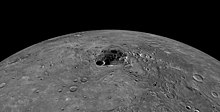Since it turns out the biggest science story is not from Mars after all, we'll instead lead in with...
1. Water and Organics Found on MERCURY (Didn't see that one coming.)
Yes, that's right. The closest planet to the Sun and the second hottest planet in the solar system apparently has frozen water and likely even organic material stuck in the shadowy craters at its poles.
On Thursday, NASA reported that multiple studies have confirmed the existence of water ice at the poles, something once thought impossible. However, despite being so close to the Sun, thanks to the tilt of the planet certain craters at Mercury's poles are in constant shadow and can actually remain at cool enough temperatures for ice to form.
As if discovering water ice on Mercury isn't enough, scientists also now suspect the dark material at the poles contains complex organic compounds, most likely delivered by asteroid or comet collisions (also likely the reason for the ice).
This is really cool news. It shows even in a hostile environment like Mercury, the basic building blocks exist for life to form. That might mean that in the universe, it's not uncommon for these basic things to exist together in many, many places. But do they always lead to life? Clearly not. Scientists are almost completely certain that despite water and organics on Mercury, life never formed there.
Now if only we could get this type of news from Mars. (HINT HINT, Curiosity.) (Yes, I still might be smarting over the rumors from last week.) Okay, onto something that will get me excited again.
2. DNA Photographed!
 | ||
| Credit: Enzo Di Fabrizio |
For the first time ever, DNA has been directly photographed! Enzo Di Fabrizio, a physics professor at the Magna Graecia University in Catanzaro, Italy, used an electron microscope to get the image above.
Along with his colleagues, Di Fabrizio got strands of DNA to get "stuck" stretched between two silicon pillars and sent a bunch of electrons through the silicon. The molecules were then illuminated and captured on camera.
Now, this image isn't actually one isolated double helix. It's actually a few DNA strands wrapped around each other. The procedure used to photograph them would actually damage a single DNA strand too badly and it would disintegrate if it wasn't a part of a collection of DNA strands. In the future, they hope to modify their techniques so that they can get an image of one double helix. Then perhaps even move onto RNA! For a bio nerd like me, these are some really exciting prospects.
However, the geo nerd side of me loves THIS story:
3. Grand Canyon Much Older Than We Thought!
The generally accepted age of the Grand Canyon in Arizona is around 6-7 million years old, but new evidence suggests it might be closer to 70 million.
"Our research implies that the Grand Canyon was directly carved to within a few hundred meters of its modern depth by about 70 million years ago," said Dr. Rebecca Flowers of CU-Boulder. She and her team looked at the radioactive decay of uranium and thorium atoms to helium in the mineral apatite to determine at what point the rock of the canyon walls got close to the surface from the effects of erosion. She makes it clear that this new date only applies to the Western portion of the canyon, and that other sections of the canyon may have formed later and combined together into what we see today.
The Grand Canyon has been notoriously difficult to date, so this new date will likely be met with controversy. However, I think this new dating method described in the article above has a lot of merit to it, and wouldn't be surprised if it's close to correct.
If it is, that means when you visit the Grand Canyon and stand looking down into it, you could conceivably be standing where a T. rex once stood, gazing at a nearly identical sight.


No comments:
Post a Comment